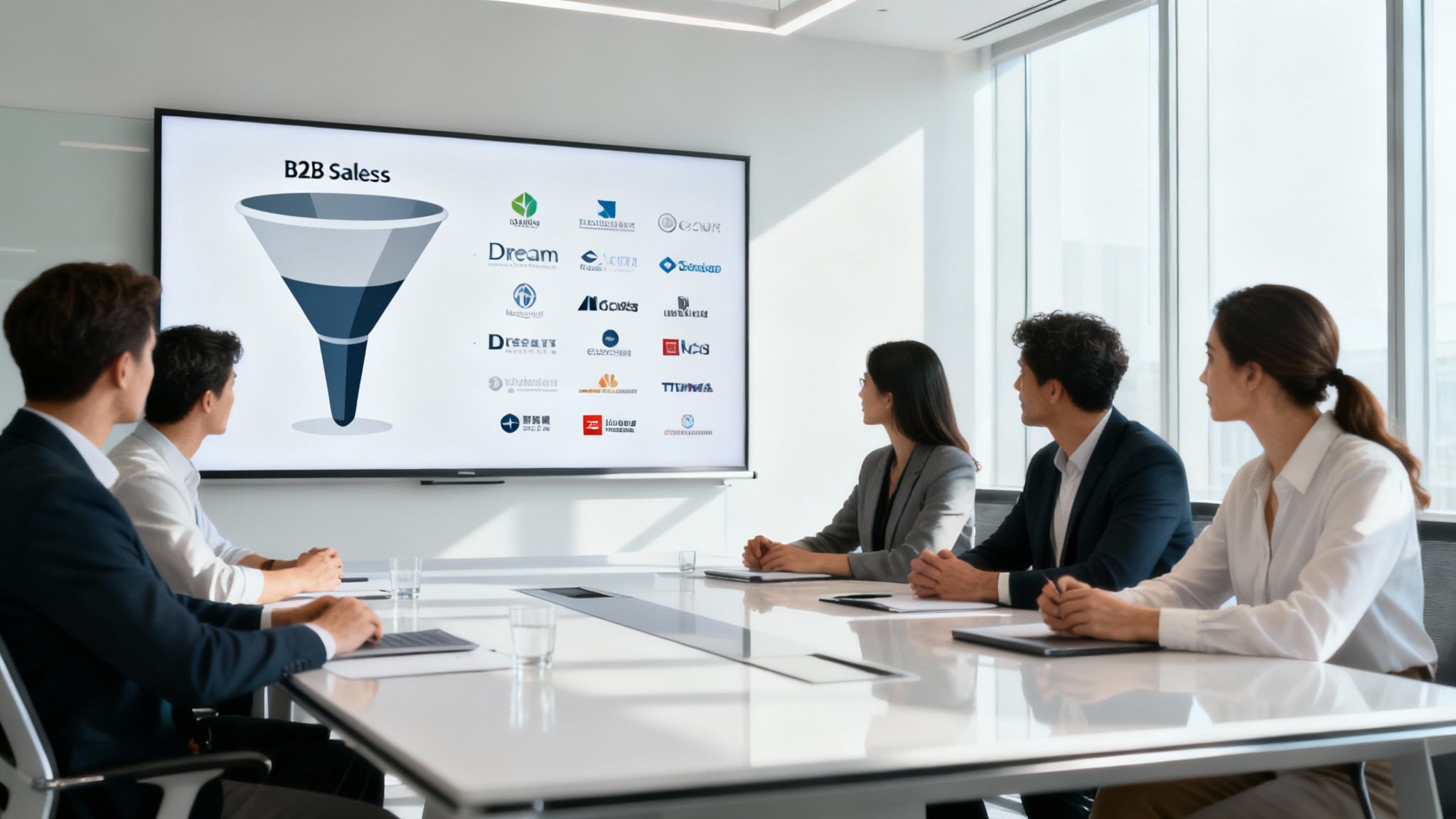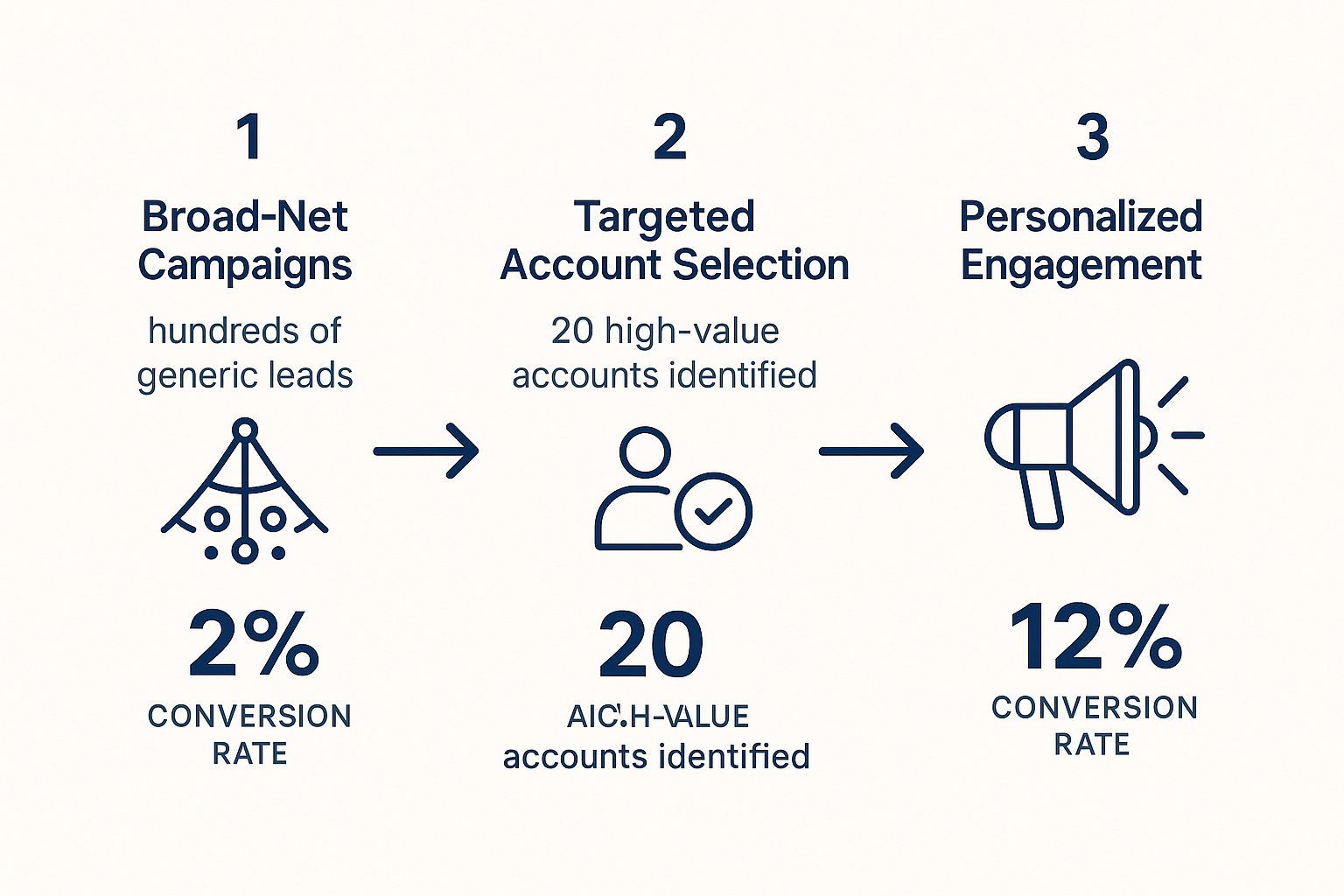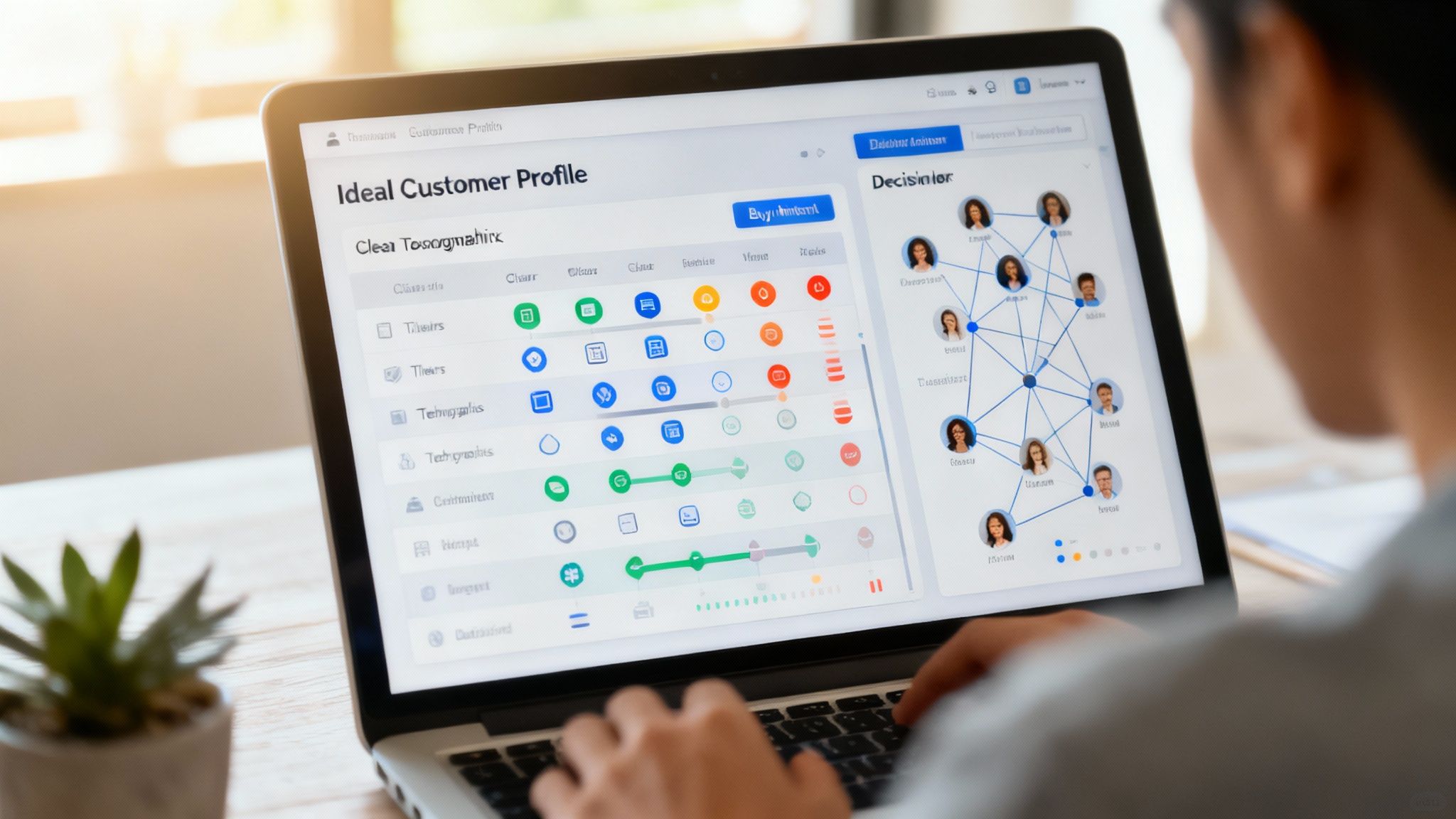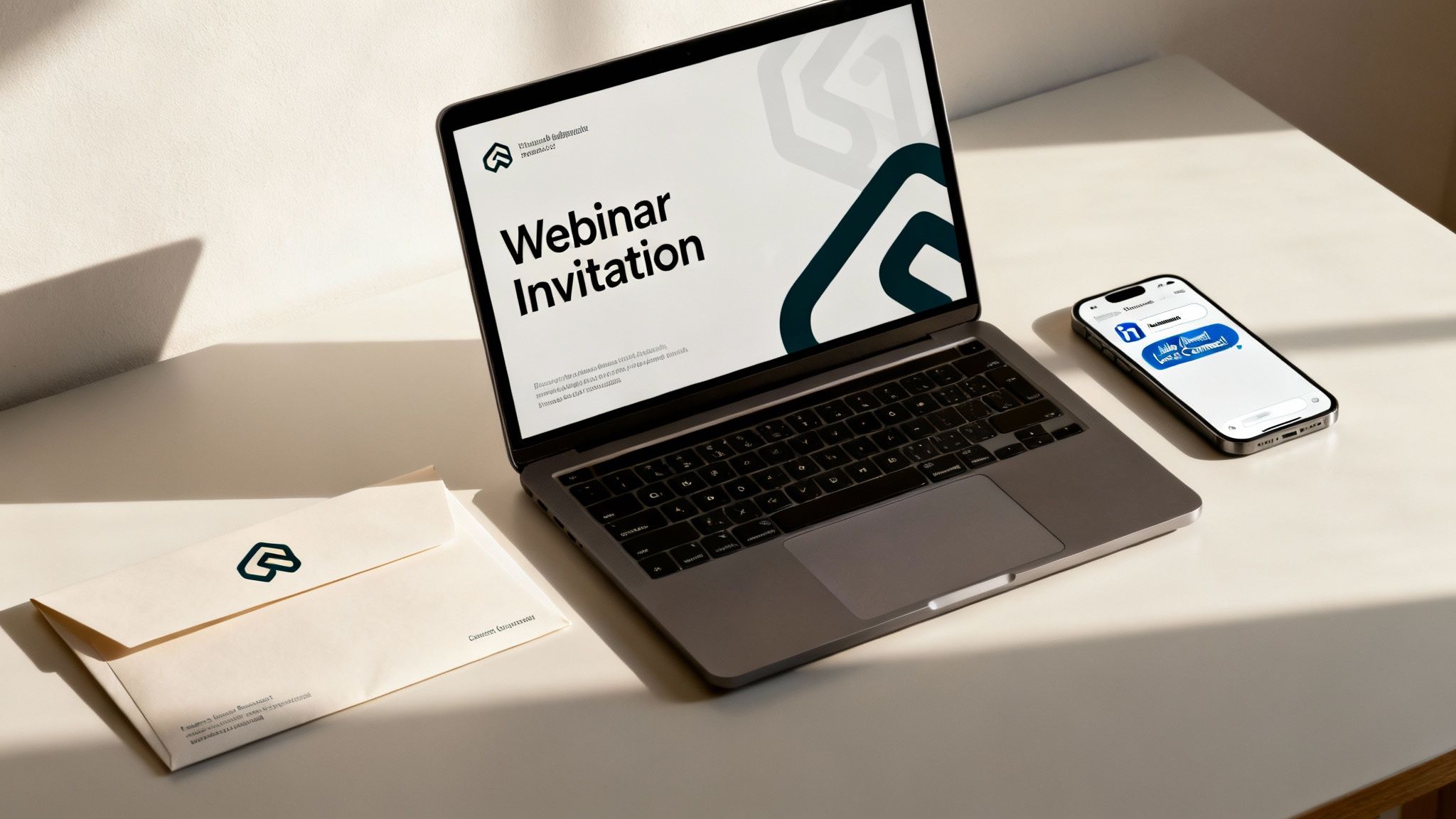Tiering Accounts in Sales: A Simple Framework to Target High-Value Prospects
Discover tiering acounts in sales with a practical framework to prioritize high-value targets and boost conversions.
Unlock higher deal values with account based selling. This guide provides a proven framework for targeting and winning high-value B2B accounts.
TL;DR: Stop chasing low-quality leads and start landing dream clients. Account based selling (ABS) flips the traditional sales model by focusing all your energy on a small list of high-value accounts. This guide shows you how to build a framework for bigger deals, shorter sales cycles, and better customer relationships.
Tired of chasing an endless stream of low-quality leads that go nowhere? It’s a common frustration. Account based selling (ABS) flips that entire model on its head. Instead of casting a wide net, you focus all your sales and marketing energy on a curated list of high-value, dream accounts.
This isn't just a small tweak to your process; it's a fundamental shift from volume to value. Think of it as trading a shotgun for a sniper rifle. The result? Bigger deal sizes, shorter sales cycles, and much stronger, more profitable customer relationships.
So, what exactly is account based selling? At its core, it's a hyper-focused strategy where you treat each high-value account like its own market. Sales and marketing teams stop working in silos and instead collaborate intensely to land and expand specific target companies.
This kind of strategic alignment is crucial today. It ensures every touchpoint, every piece of content, and every conversation is personalized and genuinely relevant to that specific account's problems.

When you deeply understand the unique challenges and goals of an account, you can craft solutions that truly hit the mark. A big part of mastering this involves getting good at spotting key buying signals—something you can dive deeper into by understanding how to effectively use B2B intent data.
For years, the B2B sales playbook was all about volume. The traditional sales funnel was basically a giant net—you cast it as wide as possible, hoping to catch hundreds of leads and praying a few good ones were in the mix. This approach forces sales reps to burn countless hours sifting through unqualified leads, most of whom were never going to be a good fit in the first place.
That old model is not just inefficient; it's expensive. It also creates a ton of friction between sales and marketing, who can rarely agree on what a "qualified" lead even is. The result? Wasted budget, frustrated teams, and missed revenue targets.
Account based selling flips this entire philosophy on its head.
Instead of starting with a massive, messy pool of leads, account based selling starts with the accounts you want to win. It's a strategic pivot from a reactive, volume-based game to a proactive, value-based one. This "flipped funnel" model is all about quality and precision, right from the very beginning.
Here’s a simple way to visualize how this works. You start by identifying the right accounts, then you focus on expanding your engagement inside them.

As you can see, rather than filtering down from a huge number of leads, you begin by picking your key accounts. Then, all your effort goes into engaging them and expanding your reach within those specific organizations.
The core idea is simple but incredibly powerful: stop talking to everyone and start having meaningful conversations with the companies that can truly transform your business. Every resource, from marketing campaigns to sales outreach, becomes laser-focused on a curated list of ideal clients.
This isn't just some niche trend; it's become a dominant strategy in modern B2B sales. In fact, 70% of marketers now run an active Account-Based Marketing (ABM) program. Companies are putting real money behind it, too, dedicating an average of 29% of their marketing budgets to this strategy. Why? Because it works. A staggering 87% of marketers report that it delivers a higher return on investment than any of their other efforts. You can discover more insights about these marketing stats on revnew.com.
Let’s get practical. Imagine your SaaS company runs broad digital ad campaigns. You generate hundreds of leads, but the sales team quickly finds that most are from companies too small to afford your enterprise solution or from industries that just don't fit your product. Your conversion rate is a dismal 2%.
Now, let's switch to an account based selling mindset.
The difference in outcomes is dramatic. Focusing your resources on a smaller number of high-value targets drives up conversion rates and average deal size, proving that value beats volume every single time.

This is where the rubber meets the road. Shifting to an account based selling model isn't just a strategy session—it's about building a repeatable system that turns your big ideas into day-to-day actions.
This framework is the engine that will power your entire ABS motion. It's what gets sales and marketing pointing in the same direction, focused on the same high-value targets. The whole process kicks off by getting brutally honest about who you're selling to. From there, it's about building a focused list, figuring out who the key players are, and creating a unified plan of attack.
Let's walk through how to build this thing from the ground up.
The absolute foundation of any good ABS strategy is a razor-sharp Ideal Customer Profile (ICP). And I don't mean just industry and company size. A great ICP is a living, breathing portrait of the companies that get the most out of your solution—and, in turn, give the most value back to you.
Think about your best customers right now. What do they really have in common? Your ICP needs to be built on real data, both the hard numbers and the softer, qualitative stuff.
To get beyond the basics, you have to layer in deeper intelligence:
A well-defined ICP isn't just a document; it's a filter. It stops you from wasting time and money on accounts that were never going to be great partners anyway. It’s the difference between guessing and knowing.
Once your ICP is locked in, it’s time to build your target account list. This has to be a joint effort between sales and marketing—if it’s done in a silo, it’s doomed from the start. Use your ICP as the blueprint and start finding companies that fit the mold.
But here’s the key: not all target accounts are created equal. You have to tier them to make sure your resources are being spent wisely. This lets you match your level of effort to the potential payoff of the account.
Here’s a simple way to think about tiering:
This tiered system keeps your team from spreading themselves too thin. It makes sure your most intense, resource-heavy work is saved for the accounts that can actually move the needle.
Winning a high-value account is almost never about convincing just one person. These days, enterprise deals involve an average of 14 or more stakeholders, creating what we call the buying committee. A huge part of your ABS framework is mapping out who these people are and what makes them tick.
You’ve got to identify and connect with a few key personas:
For every single target account, the goal is to create a multi-threaded engagement plan. You can’t risk putting all your eggs in one basket with a single contact. You need to build relationships across the entire buying committee, all at the same time.
A crucial part of your framework is knowing how to find these accounts and move them through your sales process. For more on that, check out some expert advice on building a robust sales pipeline.
This might be the most important—and frankly, the hardest—part of the whole process. Account based selling flat-out fails if sales and marketing are running in different directions. Real alignment means shared goals, shared KPIs, and shared responsibility for the revenue that comes from your target accounts.
The old way of thinking—marketing gets measured on leads, sales on deals—has to go. Instead, both teams should be looking at the same dashboard.
Before we dive into the new model, let's look at how the traditional approach stacks up against ABS.
This table really highlights the mindset shift. You're moving from a wide, volume-based game to a narrow, value-focused one.
| Stage | Traditional Sales Funnel (Volume) | Account Based Selling (Value) |
|---|---|---|
| Top | Generate a high volume of leads (MQLs) | Identify a focused list of high-value accounts |
| Middle | Nurture leads with broad content | Engage key stakeholders with personalized content |
| Bottom | Qualify leads into opportunities (SQLs) | Develop deep relationships and build consensus |
| Goal | Convert individual leads into customers | Land and expand within target accounts |
The difference is clear. Instead of waiting for leads to fall into the funnel, you're hand-picking the accounts you want to win and going after them with a coordinated strategy.
This means both teams need to be measured on metrics like:
When sales and marketing are rowing together, powered by shared goals and a solid framework for detailed account planning, the results are undeniable. The whole thing becomes a well-oiled machine built to land and expand your most valuable customers.

Let's be honest. Generic outreach is the fastest way to get your message ignored. After all the work you put into defining your ICP and building a target account list, the last thing you want is to stumble at the finish line with a copy-paste email that screams, "I don't know you."
This is where the real magic of account based selling happens. It’s all about creating personalized "plays" that are so relevant and timely they feel less like a sales pitch and more like a helpful consultation. That’s how you capture an executive’s attention and open the door to a real conversation.
In an ABS world, personalization means more than just dropping and Salesmotion into a template. It's about showing you’ve done your homework—that you have a genuine grasp of their business challenges, strategic goals, and the industry pressures they're up against.
This means your outreach might reference a key takeaway from their latest earnings call, a new initiative you spotted in their annual report, or even a challenge a C-suite leader mentioned on a recent podcast. It’s about connecting the dots for them and showing precisely how your solution fits into their world, right now.
The goal isn't just to get a response; it's to earn their respect. When a prospect sees you've done your homework, they're far more likely to see you as a credible advisor rather than just another salesperson.
Of course, this level of detail requires a solid foundation of research. A structured approach is the only way to turn raw insights into compelling outreach. If you need a hand organizing your research process, our ultimate account research checklist is a great place to start.
Relying on a single channel is a rookie mistake in ABS. The best campaigns are an orchestrated effort across multiple touchpoints, all working together to tell one cohesive story. You want to surround the buying committee with value in a way that feels helpful, not intrusive.
Imagine you're targeting a large enterprise software company. A multi-channel play might look something like this:
This sequence creates a powerful narrative. Each touchpoint builds on the last, reinforcing your message and demonstrating a deep commitment to understanding their business. It’s a world away from a generic email blast.
In account based selling, creativity is your biggest asset. The more you can tailor your approach to the specific account, the better your results will be. It’s all about breaking through the noise with something genuinely memorable.
Think beyond the standard email cadence.
Plays like these take more effort, no question. But their impact is exponentially greater. They position your team as partners who are invested in the account's success long before any deal is signed.
Ultimately, crafting outreach that connects comes down to empathy and effort. It's about proving you understand the prospect's world and have something of genuine value to offer. When you get that right, you're not just selling; you're building the foundation for a long-term partnership.
When you pivot to an account based selling model, your old dashboard is toast. Chasing traditional metrics like MQL volume is like measuring a marathon in inches—it’s technically data, but it completely misses the point. In ABS, the goal isn't just to fill the top of the funnel; it's to build deep, valuable relationships within a handpicked list of high-value accounts.
This means you need a whole new set of gauges. Your focus shifts from quantity to quality. Success is no longer about how many fish are in your net, but about the size and health of the specific ones you're trying to land.
The most common mistake I see teams make is trying to slap their old sales funnel metrics onto their new ABS program. An uptick in website traffic or a high number of demo requests from companies that aren't on your target list might look good on paper, but in an account based world, it's just noise.
You need to track indicators that tell you if you're making real headway within the accounts that actually matter. The focus moves from individual lead actions to collective account momentum.
The core question is no longer, "How many leads did we get this week?" It's, "How much more engaged are our Tier 1 accounts than they were last quarter?"
This shift is crucial. It gets everyone—sales, marketing, and customer success—rowing in the same direction, focused on the same objective: meaningful engagement within your most important accounts. And it's an approach that's paying off. The global account-based marketing market is projected to jump from USD 1.4 billion in 2024 to over USD 3.8 billion by 2030.
So, what should you be tracking? Your new dashboard needs to give you a clear, at-a-glance view of your program's health. Think of it as mission control for engaging your target accounts.
Here are the essential metrics to get on there:
Building a dashboard with these key performance indicators gives you the visibility you need to make smart, data-driven decisions. For teams serious about measuring this, understanding different models for Account Based Marketing Attribution is a critical next step.
If you see high engagement scores but deals are stalled, it might point to a problem in your sales process. If deal sizes aren’t growing, maybe your outreach isn't reaching senior enough decision-makers. These metrics help you diagnose issues and constantly refine your approach. For a deeper look, check out our guide on other key account based marketing metrics you should be tracking.
Even the most thoughtfully designed account based selling strategy can hit a wall if you’re not careful. Running an ABS program is about more than just a new playbook; it's about sidestepping the common traps that can kill your momentum before you even get started.
Too many organizations jump in without fixing the foundational issues that make this approach so different from traditional sales. They end up with burned-out teams, wasted budget, and a stalled pipeline, all while wondering what went wrong.
Let's break down the biggest pitfalls and how you can steer clear of them.
The single biggest threat to any account based selling initiative is a chasm between sales and marketing. When these two teams operate in their own silos, chasing separate goals and metrics, the whole thing just falls apart.
You'll see marketing celebrating a high "engagement score" from a target account, while sales is complaining that none of the right people are actually picking up the phone.
This disconnect creates friction and burns through resources. Efforts aren't coordinated, and the customer gets a jarring, confusing experience. The heart of ABS is presenting a unified front; without it, you're just running two different strategies and calling it one name.
A classic warning sign is when sales and marketing have different answers to the question, "What does a win look like for this account?" If one team says "pipeline created" and the other says "content downloads," you've got a serious alignment problem.
To fix this, you need a shared rulebook.
The second deadly mistake is treating research like a box-checking exercise. A quick skim of a company's homepage and a few LinkedIn profiles just isn't going to cut it.
This superficial approach leads directly to generic, irrelevant outreach that gets ignored and, worse, hurts your credibility.
Remember, personalization is the engine of account based selling. Without deep, actionable intelligence, your "personalized" emails will read like they were blasted to ten thousand other people. You’ll completely miss the critical "why now" triggers that create urgency and the specific pain points that make your solution a must-have.
Here’s a simple checklist to make sure your research is deep enough to actually make an impact:
Look, I get it. Moving to a new sales strategy brings up a ton of questions. To cut through the noise, here are some straight answers to the things we hear most often about account based selling.
The easiest way to think about it is flipping the funnel upside down. Traditional sales is a numbers game where you cast a wide net for leads and sift through them. ABS starts with a hand-picked list of high-value accounts, then focuses all sales and marketing energy on engaging them with personalized outreach. It's a strategic shift from quantity to quality.
Walk before you run. A common mistake is getting too ambitious. For a pilot program, the sweet spot is usually between 10 and 20 accounts. This is small enough for your team to do the deep research required but large enough to give you meaningful data on what's working. Once you prove the ROI, you can scale up.
Kicking off an ABS pilot doesn't need to be overly complicated. Focus on three critical first steps:
Absolutely. In fact, it can be a massive advantage. Small businesses can't compete on volume, so a hyper-focused approach plays to their strengths. The core principles of focus and personalization work regardless of company size. A small business can start with just a few dream clients and use creative, low-budget tactics to make a huge impact.
Stop wasting hours on manual research and start engaging your target accounts with insights that matter. Salesmotion automates account intelligence, delivering real-time alerts and strategic POVs that empower your team to have "why now" conversations and build more pipeline. Discover how Salesmotion can transform your ABS strategy.
Discover tiering acounts in sales with a practical framework to prioritize high-value targets and boost conversions.
Stop guessing on key accounts. Download and customize these 12 proven sales account plans templates to drive strategy, align teams, and win bigger...
Discover proven B2B prospecting strategies that build pipeline and drive sales. Learn how to find high-value leads and master modern outreach.